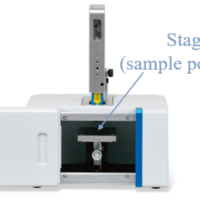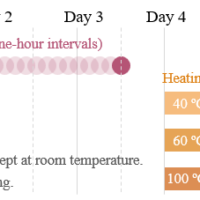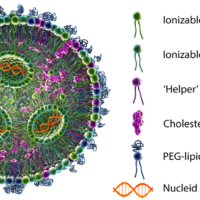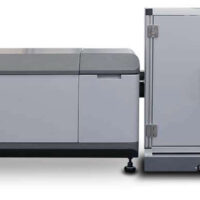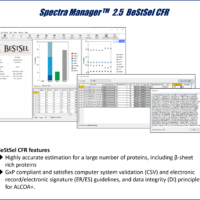Introduction
Epoxy resin is a generic term for polymers synthesized by polymerization of compounds containing epoxy groups. Epoxy resins are used in a wide range of fields such as adhesives, paints, and electronic components because of their excellent adhesive, durability, and electrical insulation properties. In order to achieve these properties, epoxy resins generally need to be cured above a certain level. Since curing is caused by the reaction of epoxy resins and curing agents, it is important to evaluate the curing process and the degree of curing in order to understand the characteristics of epoxy resins. In this report, we describe an evaluation of the degree of curing of epoxy resins used as adhesives, based on ISO 20368, using a Fourier-transform infrared (FT-IR) spectrometer.
<ISO 20368>
This standards specifies the method for evaluating the degree of curing of epoxy resins using FT-IR spectroscopy. Since epoxy resins consume epoxy groups when reacting with curing agents, the evaluation method is based on the reduction in the heights of peaks associated with epoxy groups.
Experimental
Refer to ISO 20368 for details about the measurement and analysis methods.
To evaluate the curing process and the final degree of curing, data were obtained at one-hour intervals over a period of up to 5 hours after the start of curing, and again 24 hours after the start of curing, when the final strength was reached.
Samples
Two-component mixed epoxy resins, three different adhesives:
sandwiched between two silicon wafers, this is referred as the measurement sample
Table 1 Characteristics of adhesives at around 20 ºC
| Main component | Curing agent | Pot life [h] | Time to reach practical strength [h] | Time to reach final strength [h] | |
| Adhesive A | Epoxy resin | Polythiol | 0.5 | 1.0 | 24.0 |
| Adhesive B | Epoxy resin | Modified polyamide amine | 1.0 | 12.0 | 24.0 |
| Adhesive C | Epoxy resin | Modified polyamide | 1.5 | 10.0 | 24.0 |
System
Instrument: FT/IR-4X FT/IR Spectrometer
*A sample holder is used to secure the measurement sample
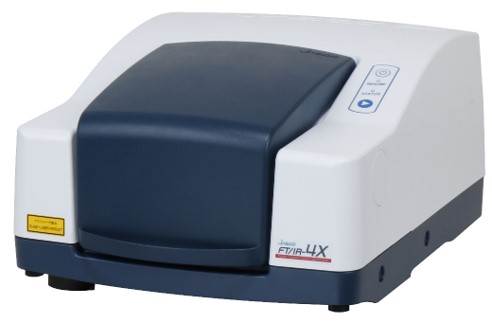
Fig. 1 FT/IR-4X FT-IR spectrometer
Parameters
Method: Transmission
Resolution: 4 cm-1
Accumulation: 16
Temperature: 20 ºC to 22 ºC
Humidity: 35 % to 40 %
Keywords
Epoxy resins, adhesive, degree of curing, ISO 20368
Results
Of Adhesives A, B, and C, the spectrum of Adhesive B, which ultimately showed the most epoxy group reduction, is shown in Figure 2.
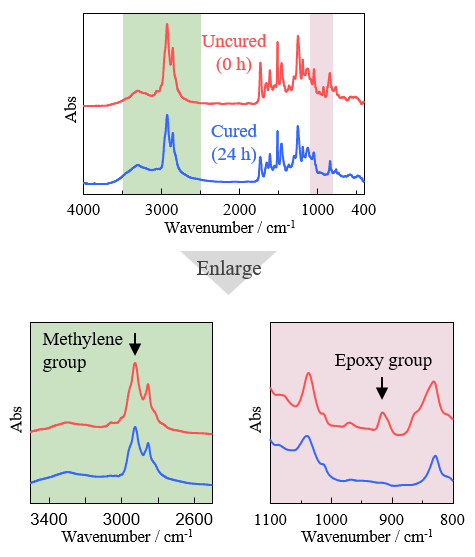
Fig. 2 Spectra of Adhesive B
The peak for methylene groups (internal standard), which does not change during the curing reaction, and the peak for epoxy groups are used to calculate the degree of curing. In accordance with the standard, we first measured the uncured adhesives as a preliminary test, and the values calculated for all three adhesives using Formula (3) in the standard were found to meet the requirements (Table 2). Measurements were then performed at the intervals described earlier to evaluate the curing process and the final degree of curing (Table 2, Figure 3).
Table 2 Results of preliminary and main tests
| Adhesive A | Adhesive B | Adhesive C | ||||
| Value calculated by Formula (3) in standard | 0.029 | 0.067 | 0.027 | |||
| Reaction time [h] | Peak height ratio (average) | Degree of curing [%] | Peak height ratio (average) | Degree of curing [%] | Peak height ratio (average) | Degree of curing [%] |
| 0 | 0.440 | 0.112 | 0.087 | |||
| 1 | 0.297 | 32.6 | 0.098 | 12.4 | 0.078 | 10.5 |
| 2 | 0.296 | 32.8 | 0.080 | 28.7 | 0.068 | 21.8 |
| 3 | 0.295 | 33.0 | 0.067 | 40.0 | 0.059 | 32.5 |
| 4 | 0.292 | 33.7 | 0.052 | 53.9 | 0.050 | 42.3 |
| 5 | 0.289 | 34.4 | 0.042 | 62.4 | 0.045 | 47.8 |
| 24 | 0.270 | 38.7 | 0.007 | 93.7 | 0.009 | 89.6 |
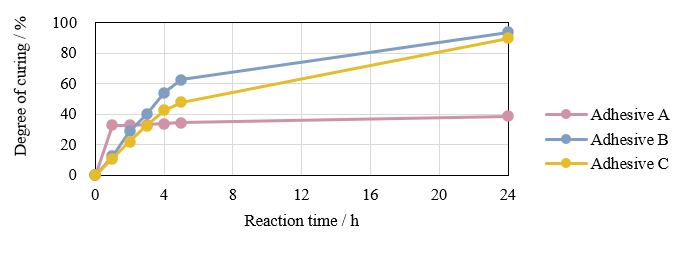
Fig. 3 Results of main test (change in degree of curing)
Conclusion
FT-IR spectroscopy allows the degree of curing to be evaluated for epoxy resins based on ISO 20368. The method described here is expected to contribute to research and development, production control, and quality control for epoxy resins.
References
Plastics — Epoxy resins — Determination of degree of curing of crosslinked epoxy resins by Fourier Transform Infrared (FTIR) Spectroscopy (ISO 20368)

